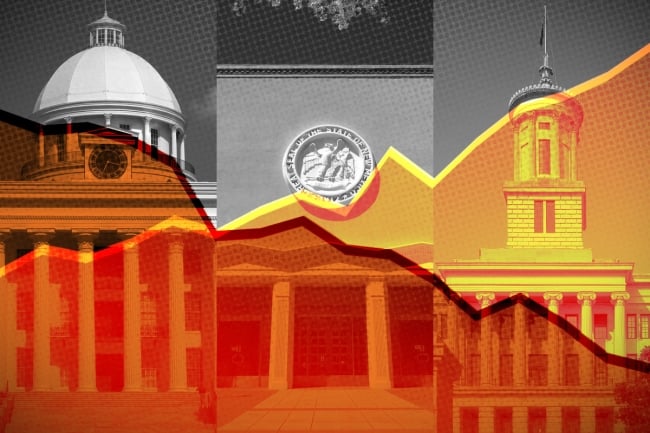You have /5 articles left.
Sign up for a free account or log in.

State higher ed funding rose in 2023, but steep enrollment declines at public colleges could undermine the money’s impact.
Photo illustration by Justin Morrison/Inside Higher Ed | George F. Landegger, Carol M. Highsmith/Library of Congress | Getty Images
State higher ed funding rose by 3.7 percent beyond inflation in fiscal year 2023, according to the latest State Higher Education Finance (SHEF) report.
It’s the second time since 2008 that state higher ed funding surpassed pre-recession levels; the first was in 2022, the prior year. That makes current public higher ed funding 6.7 percent higher than the 2008 national average.
The findings may come as a surprise to experts who predicted the post-Covid boom in state higher ed support would wane with federal pandemic aid funds.
Those funds haven’t quite disappeared yet. In 2023, $1.7 billion of state higher ed funding came from federal stimulus—about 1.5 percent of total state support. But that is a 26.6 percent decline from 2022, when more than $2.2 billion in federal aid helped beef up higher ed budgets.
Kelsey Kunkle, author of the report and a policy analyst at the State Higher Education Executive Officers Association (SHEEO), said the data from 2023 showed that many states were willing to boost funding to fill that gap: even without the federal stimulus money, state higher ed funding would be up 5.2 percent.
“A number of states that had been using federal stimulus funding for higher ed are now showing a really strong commitment to higher education, which we are extremely happy to see,” Kunkle said.
Financial aid represented the largest growth area for state support, increasing by 2.5 percent from 2022 to reach an all-time high of $1,050 per full-time student. Kunkle said those investments have helped lower the average student’s financial burden for public higher ed; there are now only 21 states where public university students shoulder more than half the share of college cost. And states are still putting money into expanding grant offerings and even free college programs, like Minnesota’s North Star Promise, in FY 2024.
“We’re seeing lots of states really work to move the needle on that,” she said. “It is a very encouraging development.”
A Last Hurrah?
The promising upward trend in state support is clouded by the fact that public higher ed institutions are also bleeding money from a worsening enrollment crisis.
The SHEF report found that net tuition revenue at public colleges and universities declined by 3.3 percent in 2023, the largest year-over-year drop since at least 1980, when the SHEF dataset was established. Full-time enrollment at public institutions fell by 0.5 percent from 2022, and was down by 12 percent from its peak in 2011.
And if completion rates hold for the Free Application for Federal Student Aid—they’re down nearly 25 percent this year thanks to the new form’s bungled rollout—enrollments are likely to take a massive hit next year, especially at public institutions that serve a higher share of students on federal aid.
Fewer students not only means lower tuition revenue for public institutions; it also means less access to state and federal grant money, which is apportioned on a student-by-student basis. In states with enrollment-based funding, it would mean a decrease in state support overall. Some states have removed such a consideration for state grants—West Virginia governor Jim Justice did so last week by declaring a state of emergency—but Kunkle said whether others follow suit will depend largely on budgetary constraints.
“I can’t imagine the FAFSA debacle won’t affect state funding, and especially enrollment,” Kunkle said. “We won’t be able to see the results of that in our data for at least one more year … but we all share a grave concern.”
Eric Syverson, a senior policy specialist at the National Conference of State Legislatures who studies tax policy and state budgets, said that given the demise of federal aid, declining tuition revenue and fallout from the FAFSA fiasco, he believes the two-year streak of booming state higher ed support is over.
“It’s not going to be possible to have investments in that order of magnitude over the next few years,” he said. “I think there are some hard decisions to be made in many states.”
Highlights and Lowlights
The latest data show a few outliers in state funding for higher ed, with some far above the norm and some well below it.
In Alabama, support for public colleges rose by 86.4 percent thanks to a one-time “Trust Fund” bill that pumped an extra $110 million into the state’s higher ed budget. And funding rose by 20 percent in Massachusetts, thanks largely to the new MASSGrant program, which expanded the state’s free tuition threshold to families making less than $100,000.
Syverson warned that even in states that significantly increased higher ed funding in FY 2022 and 2023, revenue for fiscal year 2024 has begun to return to more typical levels after two years of ample surplus led many states to slash taxes—meaning future legislatures will have far less spare revenue for colleges.
“The time for historic investments has passed,” he said.
Other states faced steep declines in support, which Kunkle said reflected the concentrated nature of 2023’s state funding increases. While 12 states received historic funding increases, total higher ed expenditures fell in half of all states and Washington, D.C.
Kunkle said that the steepest declines were in states that have relied heavily on federal stimulus money to fund public colleges and universities, but haven’t been willing to fill in the gaps once those funds began to ebb.
Public institutions in those states—such as Vermont, where funding decreased by 15 percent, and Missouri, where it was down 10 percent—experienced the most precipitous budget declines.
“States that we know have had chronic budget challenges are increasingly unable to use [federal aid] to mask their higher education funding anymore,” Kunkle said.
A January Grapevine report for FY 2024 from SHEEO, which also produced the SHEF report, showed a promising 9.4 percent preliminary increase in state funding so far this year—a figure that is not yet adjusted for inflation—despite further drops in federal aid.
But Syverson said he fears that’s a false beacon of hope.
“These trends are attributable largely to the fact that there have been more resources and fewer students over the past couple years,” he said. “States haven’t solved the revenue question … if you cut revenue streams and hope for ongoing funding increases, your math is off.”





